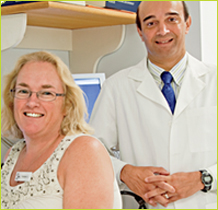Find out why having a primary care physician can help improve your health and lower healthcare costs.
For the best healthcare, you need a doctor who knows you and your medical history. A doctor who you can call with a sudden health concern. Who can help you get the tests and treatments you need. Who will ensure that all of your other doctors and healthcare providers are working together. If you don't have a primary care physician (PCP), now's the best time to find one.
Why PCPs are so important
PCPs are family physicians, general internists, general pediatricians, and geriatricians. According to the Institutes of Medicine, "Compelling evidence demonstrates better health outcomes and decreased healthcare costs when PCPs make up over 50 percent of a nation's physician supply."
Experts say that more primary care could save five million U.S. hospital admissions, reducing inpatient costs by about $1.3 billion in a single year.
Nitin S. Damle, M.D., FACP, has been practicing internal medicine in Wakefield, Rhode Island for more than 20 years. He sees about 25 patients a day. "The day is structured around well visits, acute care [care for patients who are sick], and visits for patients with chronic, ongoing medical problems," he says.
His patients' conditions range literally from head to toe: strokes and heart attacks, various types of cancers, diabetes, hypertension, pneumonia, high cholesterol, digestive problems, kidney disease, Lyme disease, depression, sprains and strains, and many others.
"I think it's important for patients and families to have one physician to turn to when they are healthy or sick, from well care to end-of-life care," says Dr. Damle. "Illness can occur at any age, though it's more probable in later years."
One of his patients can attest to this. Several years ago, while on vacation in Aruba, David Chappell became lethargic and tired. As soon as he got home, he saw Dr. Damle, who diagnosed him with jaundice, hepatitis, and anemia. "You usually look yellow when you have jaundice, but I had been tanning, so it didn't present itself that way," he says. "I had to get a blood transfusion, I lost 15 pounds, and I was in the hospital for five or six days."
A few years later during a routine visit, David was diagnosed with diabetes. He's now working closely with Dr. Damle to manage his condition and ensure that his diabetes medicines don't affect his liver, which was left slightly weaker by the jaundice. (For more on David and Dr. Damle, please see Partners in Health.)
A critical need
In the United States, fewer medical students have been choosing primary care—from 9,348 in 1998 to about 7,289 by 2005. With about $145,000 to $180,000 in student loan debt, more medical students are opting to become specialists with the potential to earn two to three times the salary of a primary care physician—and sometimes even more.
"I believe that new models like the patient-centered medical home will result in better care and allow better compensation for the time we spend with our patients," says Dr. Damle. "This will also encourage more students to enter primary care."
A new way to care for patients, the patient-centered medical home is designed with a focus on improving overall health and moderating costs over the long-term. In this setting, you establish an ongoing relationship with a PCP who leads a team of other healthcare professionals in taking proactive steps to improve your health.
How BCBSRI is supporting primary care in RI
By working with PCPs to transition their practices to patient-centered medical homes, Blue Cross & Blue Shield of Rhode Island (BCBSRI) is rewarding quality care and supporting physicians with the tools they need to provide better and more comprehensive care for you.
By the end of this year, 166 physicians and 8,500 of our members will be part of new patient-centered medical homes we're helping to develop across the state. These patient-centered medical homes include Aquidneck Medical Associates, Anchor Medical Associates, and University Internal Medicine. Also, earlier this year, we began a partnership with the Rhode Island Primary Care Physicians Corporation (RIPCPC) to establish the largest and most comprehensive patient-centered medical home in Rhode Island over the next four years. The RIPCPC has about 162 physicians.
To increase the state's primary care, we're also:
- Rewarding quality care. As part of the patient-centered medical home approach, we're rewarding our PCPs for quality of care. This includes providing additional monthly payments for patients with complicated health concerns as well as additional annual compensation for meeting certain quality metrics. We're also paying more to PCPs who use electronic health records.
- Reducing medical student loans. Last year, in partnership with the Rhode Island Foundation and the Rhode Island Medical Society, we established the Loan Forgiveness Program, which provides $20,000 a year toward medical student loans of PCPs who come to practice in Rhode Island.
- Supporting Rhode Island Free Clinic. This nonprofit organization provides free healthcare to those with no or limited access to such services. To encourage more PCPs to serve at the clinic, we donate $1,000 to the clinic for every new physician who joins its network, up to $50,000 per year. Since the program began in 2009, more than 100 new physicians have joined.
We recognize that primary care is a crucial part of comprehensive healthcare delivery. That's why we're working hard to strengthen primary care in Rhode Island with the goal of measurably improving your health and moderating your healthcare costs down the road.





